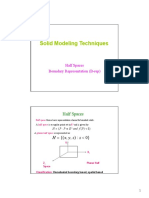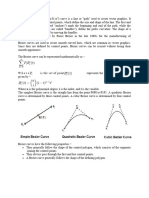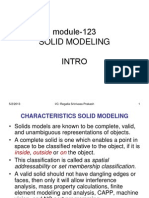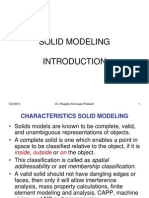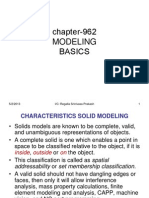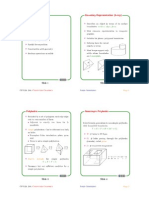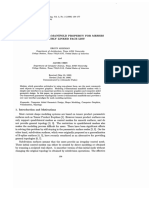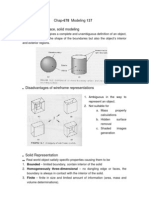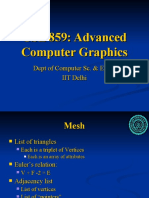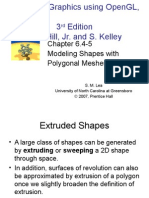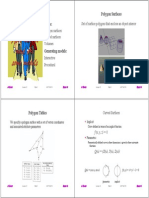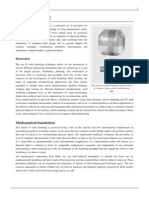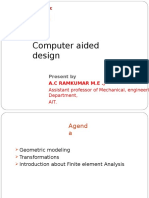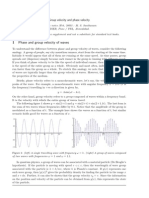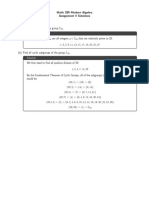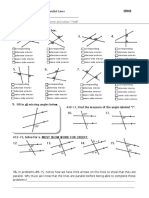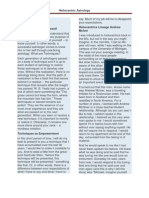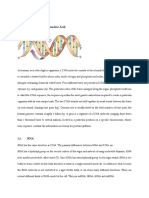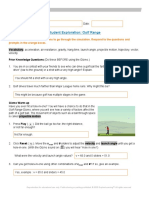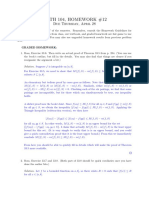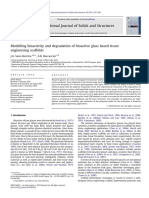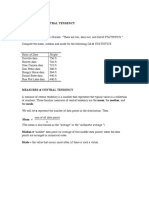AML710 CAD
LECTURE 31
Solid Modeling Techniques
Half Spaces Boundary Representation (B-rep)
Half Spaces
Half spaces form a basic representation scheme for bounded solids.
A half space is a regular point set in E3 and is given by:
H = {P : P E 3 and f ( P) < 0}
A planar half space is represented as:
H = {( x, y, z ) : z < 0}
YL XL
ZL
Planar Half Space
Classification: Unevaluated boundary based, spatial based
�Half Spaces
A cylindrical Half Space is a given by:
H = {( x, y, z ) : x 2 + y 2 < R 2 }
YL
R
XL
ZL
Cylindrical Half Space
Half Spaces
A spherical Half Space is a given by:
H = {( x, y, z ) : x 2 + y 2 + z 2 < R 2 }
YL
R
XL
ZL Spherical Half Space
�Half Spaces
A conical Half Space is a given by:
H = {( x, y, z ) : x 2 + y 2 < (tan( / 2) z ) 2 }
YL XL
ZL
Conical Half Space
Half Spaces
A toroidal Half Space is a given by:
2 2 H = {( x, y, z ) : ( x 2 + y 2 + z 2 R2 R12 < 4 R2 ( R12 z 2 )}
YL
R1 R2
XL
ZL
Toroidal Half Space
�Constructing Solids with Half Spaces
Complex objects can be modeled by combining Half Space using set operations
n S = U H I i i =0
Constructing solids with Half Space
Advantages and Disadvantages of Half Spaces
Advantages: The main advantage is its conciseness of representation compared to other modeling schemes. It is the lowest level representation available for modeling a solid object
Disadvantages: The representation can lead to unbounded solid models as it depend on user manipulation of half spaces The modeling scheme is cumbersome for ordinary users / designers
�Boundary Representation (B-rep)
Closed Surface: One that is continuous without breaks. Orientable Surface :One in which it is possible to distinguish two sides by using surface normals to point to the inside or outside of the solid under consideration. Boundary Model :Boundary model of an object is comprised of closed and orientable faces, edges and vertices. A database of a boundary model contains both its topology and geometry. Topology :Created by Euler operations Geometry :Includes coordinates of vertices, rigid motions and transformations
Boundary Representation (B-rep)
Involves surfaces that are
closed, oriented manifolds embedded in 3-space
A manifold surface:
each point is homeomorphic to a disc
A manifold surface is oriented if:
any path on the manifold maintains the orientation of the normal
An oriented manifold surface is closed if:
it partitions 3-space into points inside, on, and outside the surface
A closed, oriented manifold is embedded in 3space if:
Geometric (and not just topological) information is known
�Adjacency Topology in B-rep
VV VE VF
EV
EE
EF
FV
FE
FF
Topological Atlas and Orientability
The simplest data structure keeps track of adjacent edges. Such a data structure is called an atlas.
A
�Topological Atlas of a Tetrahedron
Topological Atlas and Orientability
The orientability indicated with arrows or numbers as shown below. We see that the orienation preserving arrows are in two opposite rotational directions i.e., clockwise and anticlockwise. While orienation reversing arrows are in the same rotational directions.
1 2 3 4 5 6 1 2 3 4 5 6
1 2 3 4 5 6 Orientation Preserving
6 5 4 3 2 1 Orientation Reversing
�Schlegel Diagrams
A common form of embedding graphs on planar faces is called Schlegel Diagram. It is a projection of its combinatorial equivalent of the vertices, edges and faces of the embedded boundary graph on to its surface. Here the edges may not cross except at their incident vertices and vertices may not coincide.
e5 e9 e1 e8 e4 e3 e12 e7 Schlegel Diagram of a Cube e11 e2 e6 e10
Atlas of Cube
An atlas of a cube can also be given by the arrangement of its faces as shown below
1 0 2 3 4 3 5 2 1
Atlas of Cube
�Some Examples of Atlases
While orienation reversing arrows are in the same rotational directions.
Cylinder
Mobius Strip
Can you think of the atlases of Torus ? Klein bottle ?
Boundary Representation (B-rep)
Non-manifold surfaces
Non-oriented Manifolds
Moebius strip
Klein bottle
�Object Modeling with B-rep
Both polyhedra and curved objects can be modeled using the following primitives
Vertex: A unique point (ordered triplet) in space. Edge :A finite, non-selfintersecting directed space curve bounded by two vertices that are not necessarily distinct. Face :Finite, connected, non-selfintersecting region of a closed, orientable surface bounded by one or more loops. Loop :An ordered alternating sequence of vertices and edges. A loop defines non-self intersecting piecewise closed space curve which may be a boundary of a face. Body :An independent solid. Sometimes called a shell has a set of faces that bound single connected closed volume. A minimum body is a point (vortex) which topologically has one face one vortex and no edges. A point is therefore called a seminal or singular body. Genus :Hole or handle.
Boundary Representation
E=4 V =4 F =1
Original object
E =5 V =5 F =1
E =5 V =5 F =1
Nonsense object Euler Operations (Euler Poincare Law): The validity of resulting solids is ensured via Euler operations which can be built into CAD/CAM systems. Volumetric Property calculation in B-rep: It is possible to compute volumetric properties such as mass properties (assuming uniform density) by virtue of Gauss divergence theorem which converts volume integrals to surface integrals.
Modified objects
10
�Leonhard Euler (1707 1783) Henri Poincar (1854 1912)
Euler-Poincare Law
Euler (1752) a Swiss mathematician proved that polyhedra that are homomorphic to a sphere are topologically valid if they satisfy the equation:
F E + V L = 2( B G ) F E +V = 2 F E +V L = B G
F=Face B=Bodies E=Edge L=Faces inner Loop
General Simple Solids Open Objects
V=Vertices G=Genus
11
�Euler Operations
A connected structure of vertices, edges and faces that always satisfies Eulers formula is known as Euler object. The process that adds and deletes these boundary components is called an Euler operation Applicability of Euler formula to solid objects:
At least three edges must meet at each vertex. Each edge must share two and only two faces All faces must be simply connected (homomorphic to disk) with no holes and bounded by single ring of edges. The solid must be simply connected with no through holes
Validity Checking for Simple Solids
F E + V = 2 Simple Solids
E = 10 V =6 F =6 6 10 + 6 = 2
E = 12 V =8 F =6 6 12 + 8 = 2
E =8 V =5 F =5 58+5 = 2
E = 24 V = 16 F = 10 10 24 + 16 = 2
12
�Validity Checking for Simple Solids
F E + V = 2 Simple Solids
E =3 V =2 F =3 33+ 2 = 2
E=2 V =2 F =2 22+2 = 2
E=2 V =2 F =2 22+2 = 2
Loops (rings),Genus & Bodies
Genus zero
Genus one
Genus two
One inner loop
13
�Validity Checking for Polyhedra with inner loops
F E + V L = 2( B G )
E = 36 F = 16 V = 24 L=2 B =1 G=0 16 36 + 24 2 = 2(1 0) = 2
General
Validity Checking for Polyhedra with holes
F E + V L = 2( B G )
E = 24 F = 12 V = 16 L=0 B=2 G=0 12 24 + 16 0 = 2(2 0) = 4
General
Interior hole (void)
E = 24 V = 16 B =1
Surface hole
F = 11 L =1 G=0
11 24 + 16 1 = 2(1 0) = 2
14
�Validity Checking for Polyhedra with through holes (handles)
F E + V L = 2( B G )
E = 24 F = 10 V = 16 L=2 B =1 G =1 10 24 + 16 2 = 2(1 1) = 0
General
Through hole Handles/through hole Wireframe polyhedra Lamina polyhedra
E = 48 F = 20 V = 32 B =1 L=4 G =1
20 48 + 32 4 = 2(1 1) = 0
Validity Checking for Open Objects
F E +V L = B G
Shell polyhedra
Open three dimensional polyhedra
15
�Exact Vs Faceted B-rep Schemes
Exact B-rep: If the curved objects are represented by way of equations of the underlying curves and sufraces, then the scheme is Exact B-rep. Approximate or faceted B-rep :In this scheme of boundary representation any curved face divided into planar faces. It is also know as tessellation representation.
Exact B-rep: Cylinder and Sphere
Faceted cylinder and sphere
Data structure for B-rep models
F E + V L = 2( B G )
Topology Object Body Genus Face Loop Edge Vertex Underlying curve equation Point coordinates Underlying surface equation Topology
General
16
�Winged Edge Data structure
All the adjacency relations of each edge are described explicitly. An edge is adjacent to exactly two faces and hence it is component in two loops, one for each face. Successor 1 Predecessor 2
v2
F1 F1 E F2
F2
v1
Predecessor 1
Successor 2
As each face is orientable, edges of the loops are traversed in a given direction. The wingded edge data structure is efficient in object modifications (addition, deletion of edges, Euler operations).
Building Operations
F E + V L = 2( B G )
Operation Initiate Database and begin creation Create edges and vertices Create edges and faces Operator MBFV MEV MEKL MEF MEKBFL MFKLG KFEVMG KFEVB MME ESPLIT KVE Complement KBFV KEV KEML KEF KEMBFL KFMLG MFEVKG MFEVB KME ESQUEEZE
General
Description Make Body Face Vertex Make Edge Vertex Make Edge Kill Loop Make Edge Face Make Edge Kill Body, Face Loop Make Edge Kill Loop Genus Kill Face Edge Vertex Make Genus Kill Face Edge Vertex Body Make Multiple Edges Edge Split Kill Vertex Edge
The basis of the Euler operations is the above equation. M and K stand for Make and Kill respectively.
Glue Composite Operations
17
�Transition States of Euler Operations
F E + V L = 2( B G ) General
While creating B-rep models at each stage we use Euler operators and ensure the validity.
Operator MBFV MEV MEKL MEF MEKBFL MFKLG KFEVMG KFEVB MME ESPLIT KVE F 1 0 0 1 -1 1 -2 -2 0 0 -(n-1) E 0 1 1 1 1 0 -n -n n 1 -n V 1 1 0 0 0 0 -n -n n 1 -1 L 0 0 -1 0 -1 -1 0 0 0 0 0 B 1 0 0 0 -1 0 0 -1 0 0 0 G 0 0 0 0 0 -1 1 0 9 9 9
F E + V L = 2( B G )
MBFV
Euler Operations
MEV KEV MEKL KEML
MEF KEF
18
�F E + V L = 2( B G )
MEKBFL KEMBFL
Euler Operations
MFKLG KFMLG
GLUE(KFEVMG) UNGLUE(MFEVKG)
F E + V L = 2( B G )
GLUE(KFEVB)
Euler Operations
B
UNGLUE(MFEVB)
MME KME MME KME KVE
19
�Building operations
MME
MBFV
MEF
MME
MEF, MEF, MEF, MEF, MEF
Merits and Demerits of Euler Operations
If the operator acts on a valid topology and the state transition it generates is valid, then the resulting topology is a valid solid. Therefore, Eulers law is never verified explicitly by the modeling system. Merits:
They ensure creating valid topology They provide full generality and reasonable simplicity They achieve a higher semantic level than that of manipulating faces, edges and vertices directly
Demerits :
They do not provide any geometrical information to define a solid polyhedron They do not impose any restriction on surface orientation, face planarity, or surface self intersection
20
�Advantages and Disadvantages of B-rep
Advantages:
It is historically a popular modeling scheme related closely to traditional drafting It is very appropriate tool to construct quite unusual shapes like aircraft fuselage and automobile bodies that are difficult to build using primitives It is relatively simple to convert a B-rep model into a wireframe model because its boundary definition is similar to the wireframe definitions In applications B-rep algorithms are reliable and competitive to CSG based algorithms
Disadvantages :
It requires large storage space as it stores the explicit definitions of the model boundaries It is more verbose than CSG Faceted B-rep is not suitable for manufacturing applications
21
